The MKT1 Field Guide to B2B startup marketing | Part 1
A breakdown of the MKT1 Method: My system of marketing frameworks, methods, and processes
👋 This is a monthly free edition of MKT1 Newsletter—a deep dive into a B2B startup marketing topic, brought to you by UserEvidence, RevenueHero, and 42Agency.
Upgrade to a paid subscription to get 100+ templates & resources, a vetted contractor & agency list, exclusive discounts on marketing tools, free posts on the MKT1 job board, and full access to the MKT1 archive including bonus newsletters.
Over the years of writing MKT1, what started as ad hoc commentary on how to actually do modern B2B startup marketing has evolved into something bigger—a connected set of frameworks, definitions, and resources. It’s become the MKT1 Method: a practical system for setting strategy, planning, executing effectively, and building marketing teams.
But as the system has grown, I find myself referencing and re-referencing past frameworks and concepts, things like the GACCS Brief, KPI vs. KPO Goals, Marketing Advantages, and Fuel and Engine. I sound like a broken record. And if you’re new to MKT1, there should be a faster way to get introduced to the methodology that underlies everything I write. And if you’re an MKT1 OG, you might want a refresher from time to time or something to share with your team to get them up to speed. So I decided to create this reference to help all of us!
If MKT1 is a map, this is the legend. If MKT1 is a skyscraper (or my preference, a mid-century cabin by a lake), this is the blueprint. If MKT1 is a human body (weird thought), this is your Gray’s Anatomy. If MKT1 is a car, this is the manual. If MKT1 is a college class, this is the (super detailed) syllabus.
Okay, I’ll stop, you get it. Let’s get to the frameworks!
Recommended products & agencies
We only include sponsors we’d recommend personally to our community. If you are interested in sponsoring our newsletter, email us at sponsorships@mkt1.co.
UserEvidence automates feedback collection and turns it into customer testimonials, ROI stats, and advocate lists. Collect feedback throughout the entire customer journey, give your reps a self-serve library of customer evidence, and instantly turn customer stories into on-brand marketing content.
🎁 Offer: Mention MKT1 for your first 2 months of UserEvidence free.
___
RevenueHero: Don't lose your best prospects to complicated scheduling. Use RevenueHero to auto-enrich and route inbound leads, or to add scheduling "magic links" to your outbound emails. It’s used by Clay, Sendoso, and Freshworks.
🎁 Offer: Mention MKT1 and get 15% off if your company buys before Sept 31st.
___
42Agency: Let 42 Agency handle the MOPS work your team avoids. From setting up routing logic, to fixing scoring and aligning Hubspot + Salesforce, 42 Agency is ready to help your B2B startup clean up and scale your ops.
🎁 Offer: Mention MKT1 to get 10% off a Hubspot Audit or Hubspot Sprint.
In this newsletter:
This Field Guide breaks down my most frequently used (across my newsletters and advising) frameworks and methodologies at MKT1. And the Field Guide itself got a bit long, so it’s now a 2-part Field Guide:
New tool for paid subscribers:
An upgraded MKT1 template library is now live at mkt1.co/template-library
🧱 Foundation: High-level marketing strategy
These frameworks lay the groundwork for everything else in marketing. Before you can effectively run campaigns, create content, or build out individual channels, you need to align on strategy at the department level.
Note: Frameworks with a ™ indicate a MKT1-specific framework, frameworks without a ™ are frameworks and concepts I’ve adapted.
➜ Avoid Random Acts of Marketing™
Framework definition:
Random Acts of Marketing (RAM) is check-the-box-style marketing work, often copying tactics from other companies without regard for what will work for your startup. RAM is the opposite of having an impact-focused strategy.
How to use:
Avoiding RAM involves setting a marketing strategy specific to your startup, making marketing plans and setting goals based on that strategy, and connecting day to day work to said strategy, plan, and goals—everything this Field Guide is designed to help with.
One practical tool: Use a traffic light system to evaluate projects, channels, content series—anything. But don’t just fixate on the reds. Spend more time doubling down on the greens, where you’re already seeing traction, and let the reds go. Build a strategy based on what works for your startup, and stay focused, don’t try to make every thing you can possibly do in marketing happen! Here’s a rough suggestion on how you should spend your time to maximize impact:
Why it matters:
Most startups fall into the RAM trap by copying someone else’s playbook, reacting to every random request, or endlessly iterating on incremental tactics. But breakout growth doesn’t come from scattered activity. It comes from a plan tailored to your company, with deliberate, high-upside bets. And once you have that plan, stick to it. Just because your founder saw a billboard or heard something on a podcast doesn’t mean you should drop everything and chase it. (Yes, founders, we love you—but we see you.)
Additional reading:
Newsletter: How to prioritize marketing activities & avoid random acts of marketing
Exercises & template: Prioritization list & start, stop, continue exercise & Marketing Decision Dashboard, No RAM checklist (for free subscribers too!)
—
➜ Balance Fuel and Engine™ to operate effectively
Framework definition:
To build an efficient marketing machine, you need to balance and combine both fuel and engine. Think of your marketing “fuel” as everything you say and create for your audience (out loud, in writing, or visually) and your “engine” as all of the channels and processes you use to distribute the fuel out to your audience.
How to use:
When making fuel, think about the engine you’ll use to distribute it from the start. When choosing your engines, make sure you have the capacity to create the right fuel for those engines. And choose your fuel and engine based on your audience needs and preferences! You can also run a regular analysis of your fuel and engine mix to drive marketing planning and hiring efforts.
Why it matters:
Startups usually over-index on fuel or engine. Meaning, you spend way too much time creating fuel and sacrifice building out a good engine, or vice versa. Or you build fuel and engine that don’t match each other, or that don’t match with what your audience wants and where they spend time. When your fuel-engine mix isn’t balanced, your marketing efforts are inefficient.
Additional reading:
Newsletter: Building an efficient marketing machine: the fuel & the engine
Exercise: Analyze your Fuel & Engine balance
—
➜ Find & accelerate your Marketing Advantages™
Framework definition:
Marketing Advantages are positive dynamics and/or strengths in a company’s business, product, team, or story. When advantages are leveraged they can help you grow much faster and differentiate your marketing strategy compared to competitors. In other words, they are catalysts for growth.
How to use:
Startups need to recognize, prioritize, and accelerate these advantages to win. Tailor your marketing strategy, content, and channels based on your specific advantages. To identify Marketing Advantages, I made the above list of the most common advantages and organized them into 4 categories based on what drives that advantage. You may discover additional advantages unique to your company, but remember: It’s not an advantage if everyone else has it and leverages it in the same way.
A couple examples of advantages:
Salesforce had demand for (and ability to execute) on events plus a compelling founder-driven story
Zapier had channel mastery of programmatic SEO and when combined with integrations drove tons of inbound traffic (this likely wouldn’t work as well today!)
Vanta had extreme market tailwinds when SOC2 was a new compliance framework
Clay built a community that helps feeds the demand for educational content, and then leverages a free trial
Why it matters:
With lower barriers to building great products, marketing is now the differentiator. Most successful late-stage companies leveraged 2+ Marketing Advantages to get where they are today. If your startup doesn’t have clear Marketing Advantages, you need to adjust your product, business strategy, or go-to-market approach.
Additional reading:
Newsletter: Find & accelerate your Marketing Advantages to grow much faster
Resource: Marketing Advantages checklist
—
➜ Build marketing based on the Three Drivers of Marketing Strategy™
Framework definition:
The 3 Drivers of Marketing Strategy shape everything else you do in marketing. Look to your audience and market (aka product marketing research), your GTM motion and business model, and your Marketing Advantages to help you make a strategy that will work for your specific startup at this moment in time.
How to use:
Product marketing research: Product marketing research is the foundation for almost everything you do in marketing—and it doesn’t just include understanding your product. It means deeply understanding your audience, market & ecosystem, and product, plus how they fit together. Use this research and understanding to drive marketing strategy and inform your positioning, audience segmentation, creative work, channel selection, and campaign planning. Read more on this process here.
Business model & go-to-market motion: Growth marketing at a B2B company with a self-serve motion compared to a sales-led motion is a different job—almost as different as B2C and B2B marketing. Marketing a product with a $100K average contract value (ACV) and a $5K ACV is also wildly different. Given this, your growth marketing strategy and tactics need to be 100% aligned with your business model and GTM motion. These factors dictate your budget, your org chart and marketing role definitions, and the channels that will be most successful for acquiring, nurturing, converting, and expanding customers. Read more on this here.
Marketing Advantages: I spelled these out above. Understanding the other 2 drivers (product marketing research & your GTM motion) first helps you identify your Marketing Advantages more easily. Once you identify your advantages, it’s obvious where to focus the bulk of your marketing efforts: on work that accelerates these advantages and leans into your strengths.
Why it matters:
You cannot copy another company’s marketing strategy and expect it to work for your startup. The good news is, no two companies have exactly the same audience, business model & GTM motion, and advantages at the same stage and same moment in time. So if you use those things to guide your efforts, you’ll build a differentiated and likely effective marketing strategy.
Additional reading:
Newsletter: How to build your growth (marketing) strategy
Exercise: Marketing Strategy Drivers exercise for Fuel and Engine tactics
—
➜ Prioritize the 4 Revenue Levers™
Framework definition:
There are really only 4 high-level ways to grow revenue in B2B marketing. I call these Revenue Levers.
Increase top of funnel with your core audience: In other words, capture more of the same pie, gaining more market share with the same audience over time.
Increase top of funnel by targeting a new ICP: In other words, expand the pie or go after a larger market with the same or new product.
Increase value of customers: By increasing pricing, driving more upsell and expansion revenue, or by changing your customer mix to larger value customers (i.e. getting more enterprise customers than SMB) you can change the average value per customer. To keep the pie metaphor going, think of this as selling more expensive pies!
Increase efficiency: By improving conversion rates, decreasing customer acquisition costs, and eliminating marketing waste (less pie in the trash!), you can use the same budget to drive more revenue.
How to use:
Each lever lends itself to a specific “engine” strategy, and different levers will be higher priority for your startup at different times. Quarterly, I recommend stack ranking these levers and/or adding the percent of time marketing will spend on each. It’s important to have these prioritized and get buy-in on these priorities across your company so you can do the correct mix of growth-driving activities.
Why it matters:
Before setting goals or choosing marketing activities, you should understand your company’s highest leverage way to drive revenue right now. Ranking these levers every quarter can help you figure out where to focus your marketing plans. This also ensures you don’t just spend all your time on short-term top of funnel and pipeline volume activities, which becomes an increasingly challenging way to drive revenue as you saturate your TAM.
Additional reading:
Newsletter: Prioritizing the 4 Revenue Levers during annual planning
Exercise: Rank the 4 Revenue Levers
—
💡 If you remember one thing from this section let it be this: Use Marketing Advantages to set a differentiated strategy, balance Fuel and Engine to operate more effectively—do this and you’ll avoid Random Acts of Marketing.
A quick break to introduce something new…
Upgraded MKT1 template & resources library
We have 100+ templates, tools, and resources to help paid MKT1 subscribers implement the MKT1 method and frameworks. Until now, they lived in one very long Substack post; it was time for an upgrade.
You can now search, browse, and filter by category and template type (Looking for “fuel” templates? Want to see everything we’ve vibe coded?).
Paid subscribers can unlock with the email tied to your Substack subscription. Not yet a subscriber? Upgrade here for full access. And if you run into any issues, you can reach us here.
🧭 Team-wide planning & processes
Strategy is useless if you don’t connect it to your day-to-day work through strategic planning and clear focus. These frameworks help your marketing team stay aligned, prioritize effectively, and execute consistently.
➜ Summarize your strategy in a Marketing Decision Dashboard™ & refer to it regularly
Framework definition:
A marketing strategy cheat sheet used for prioritization. It’s helpful to have a doc, sheet, slides, or other centralized home that summarizes all the strategy inputs you need to make prioritization decisions on projects and tasks.
How to use:
I recommend making a Marketing Decision Dashboard that includes: your Marketing Advantages, your ICPs in priority order or grouped by tiers, the Perceptions™ driving your fuel strategy, the prioritized 4 Revenue Levers driving your engine strategy, and your highest-level goals as a team. Plus, whatever else you’ll find helpful when prioritizing!
Then refer to this dashboard as you execute day to day: The marketing strategy decisions in your dashboard should be referenced as fields in campaign and content roadmaps, in your marketing briefs (aka GACCS Briefs), and when setting goals—and you can ask other teams to consider these inputs when making requests too.
More on creating Perceptions, setting fuel strategy, and setting engine strategy in Part 2 of the Field Guide.
Why it matters:
We often spend time making and getting buy-in on big strategic decisions during annual or quarterly planning, and then forget we ever made those decisions. Having those big decisions in one place can massively speed up the time it takes to prioritize day-to-day, and dramatically improve your ability to pick the right, impact-driving things to work on. It’s also a great thing to circulate to other teams as a summary and reminder of your strategy. Plus, it’s a really helpful place to go when prioritization panic sets in.
Additional reading:
Newsletter: Step-by-step guide to prioritizing marketing work
Slides Template: Marketing Decision Dashboard
—
➜ Build an impact-focused annual marketing plan
Framework definition:
A shared summary document that outlines how marketing will drive revenue growth this year, set the company up for long-term success, and do so efficiently. It includes your strategy, goals, large initiatives, and forecast—all in one place.
How to use:
Use the strategic inputs from your Marketing Decision Dashboard to build an impact-focused annual plan that includes:
An overview of your marketing strategy and vision for the year, focused on how you’ll differentiate and win with marketing
Your annual KPO Goals (including non-goals, key dependencies, and risks)—more on this in the next section.
Bottom-up forecasts for budget and hiring plans
A list of big-bet projects or campaigns by quarter, with goals, audiences, and stakeholders
Links to completed strategy exercises and supporting plans
Once built, share this plan broadly and use it to guide your quarterly planning and day-to-day prioritization.
Why it matters:
Too many startups rush into forecasting and setting KPI-based OKRs just to hit company planning deadlines, without first figuring out what marketing strategy will actually help them win. If you don’t take the time to map out a clear, tailored plan, your team won’t know what to prioritize, and other teams won’t you’re focused on either. A solid plan keeps you focused, aligned, and ideally cuts down on the Random Acts of Marketing you’re inevitably going to be asked to do.
Additional reading:
Newsletter: MKT1 Guide to Annual Marketing Planning
Template: Annual marketing plan
—
➜ Set KPO Goals™, not just KPI goals
Framework definition:
KPO Goals are the 3 types of marketing goals you need to set: KPIs (key performance indicators) for metrics you plan to hit, “big bet” Projects for initiatives that could drive outsized impact, and behind-the-scenes Ops and hiring work to set you up for success. Setting all 3 types of goals—and not just KPI goals—makes sure you have a comprehensive plan that makes time for the right mix of work.
How to use:
To set KPI goals, look at your revenue forecasts and your ranked order of the 4 Revenue Levers. While the targets will shift each quarter, most of the core metrics you track will likely stay consistent over time.
To define Project goals, revisit your strategy inputs. What big bets will accelerate your Marketing Advantages, resonate most with your audience, or reinforce your Perceptions and positioning?
To determine Ops goals, list the foundational work needed to support your KPIs and Projects. Add things like hiring, implementing new tools, optimizing workflows, improving analytics, or building repeatable processes.
Why it matters:
A couple KPIs is not a marketing plan—they’re just a part of it. Marketing isn’t sales, you can’t just set a pipeline number and call it a day. Marketing is multi-disciplinary and covers the entire lifecycle, from prospect to customer to evangelist. You need goals that combine metrics and a roadmap of high-impact initiatives—much like how a product team would set goals (more on this in a minute).
You need to carve out time for strategic bets that can shift your company’s growth trajectory, and make space for the infrastructure and hiring work that keeps everything running. If you don’t plan for all three types of goals, you’ll end up stuck in linear growth mode—think of running in a hamster wheel vs climbing a set of stairs!
Additional reading:
Newsletters: MKT1 Guide to Annual Marketing Planning & Guide to Marketing Prioritization
Template: Marketing goals tracker
—
➜ Start every project with a GACCS Brief™
Framework definition:
A simple but powerful brief template that helps you scope marketing work clearly and consistently. It stands for Goals, Audience, Channels, Creative, and Stakeholders—the five essentials to align on before kicking off any project, whether a campaign, content piece, launch, or event. The GACCS brief also helps ensure you are combining fuel & engine: fuel strategy goes under creative, and engine strategy goes under channels. It’s flexible enough to use for almost any type of marketing work and lightweight enough to become a habit—and bonus, it’s kind of fun to say and reminds me (and other millennials) of Nickelodeon Gak.
How to use:
Create a GACCS Brief before starting any meaningful marketing project. When you create a new Google Doc, new Notion Doc, new Asana project, or even a new Figma file that probably means a GACCS is necessary.
You’ll need to rely on your strategic inputs (things in your Marketing Decision Dashboard especially) to make this brief and filling it out forces you to answer key questions like: Why are we doing this? Who are we targeting? What fuel and engine are we using? Who needs to be involved?
Start by making a short version to drive alignment and get buy-in, then expand on the brief to make a full project, campaign, event, or launch plan. When its time for stakeholders to review work, have them use the GACCS as a rubric as well.
Why it matters:
GACCS Briefs are the connective tissue between your strategy, your plan, and execution—and one of the highest-leverage practices for your marketing org. The GACCS Brief helps your team stay focused on the work that aligns with your strategy, audience, and goals; make smarter tradeoffs, prevent scope creep, and skip doing a bunch of work no one was aligned on in the first place.
Additional reading:
Newsletter: The GACCS Marketing Brief (old one, but still holds up!)
Template: GACCS Brief generator & template - we have both Docs templates and a Lovable app for generating them quickly
—
➜ Run initiatives using the MKT1 campaign framework
Framework definition:
At MKT1, we define campaigns as marketing initiatives that combine both fuel and engine. They’re typically focused on a specific audience segment (or set of segments), anchored around a theme, for a set amount of time. Product launches, demand gen plays, ABM initiatives, and yes, events, are all campaigns.
That’s good news: You don’t need a different playbook for each. You just need to plan cross-functionally within marketing, align fuel and engine, and start with a GACCS Brief.
Note: Campaign “objects” in Salesforce and HubSpot or campaigns set up in AdWords may be used a bit differently. I’m talking capital C campaigns here!
How to use:
For something so core to marketing, running campaigns is a complicated art that’s rarely done well. To get campaigns right, you need to combine the right fuel with the right engine, at the right time, for the right people.
Here are 5 principles for running campaigns:
You need to actually run campaigns (this one may seem obvious, but many teams don’t effectively combine fuel and engine activities and work in silos )
Plan campaigns in advance, capturing your biggest campaigns as Project goals
Each campaign needs a single DRI and tight coordination across all of marketing
Campaign briefs (aka GACCS Briefs) are not busywork, they’re a requirement
Double down on campaigns that work, don’t keep reinventing the wheel
Why it matters:
The key to driving step-change growth = campaigns. But if your marketing team is not setting a strategy and operating effectively, you’ll know instantly when you try to run a big campaign. Everything will break down. On the flip side, if you can pull off a successful large campaign, your marketing team is probably collaborating effectively.
Additional reading:
Newsletter: How to run effective campaigns
Template: Campaign roadmap
—
💡 If you remember one thing from this Team Processes section: You need to make annual and quarterly plans, no matter your company size, and you need to use GACCS Briefs for all marketing work to connect the day to day to your plans and strategy.
🧑🔧 Team-building
It’s very hard to build the right marketing strategy, make plans that drive outsized results, and execute effectively if you don’t have the right people, organized in the right way. These frameworks help you structure a marketing team, hire the right people, and explain what marketers actually do to other people at your company.
➜ Build & run your marketing team like a product team, not a sales team
Framework definition:
This is more of a mindset shift than a traditional framework. Marketing is often misunderstood and treated as a service org to sales, which limits its scope and potential impact. In reality, marketing should operate much more like a product team (which includes product, engineering, and design).
This analogy is my go-to when helping the rest of the company understand how to build and support an effective marketing team.
How to use:
Use this framework to explain what marketing is capable of, how it’s best leveraged, and why it shouldn’t be treated like a service organization to sales.
Both marketing and product are multidisciplinary functions that balance short-term execution with long-term, high-impact initiatives. They require deep audience insight and a broad mix of roles—strategists, creatives, analysts, ops, and more. Sales, by contrast, tends to be narrower in scope and focused on near-term revenue.
Why it matters:
When you run marketing like sales, you set narrow goals, hire the wrong team, and underutilize the function. But when you run it like product, marketing becomes a full-funnel, efficient, and durable growth driver.
The differences between marketing and sales are a feature, not a bug. Embracing that tension creates a more robust GTM strategy and leads to less duplicative efforts and focus areas.
Marketing should influence every stage of the customer journey, take on strategic bets, and ship fuel-and-engine work that delivers real value to your audience. As GTM channels get noisier and growth gets harder, the teams that treat marketing like a product org—not a quarterly lead machine—will be the ones that break out.
Additional reading:
Newsletters: 4 ways marketing is different from sales & How to hire a marketing team
Templates: Org chart & hiring templates - to hire for the right mix of multi-disciplinary roles
—
➜ Organize your team into 3 sub-functions
Framework definition:
B2B startup marketing teams typically have 3 sub-functions: product marketing (foundation), content/brand/design (fuel), and growth marketing (engine). This structure ensures you have a multidisciplinary team that can create the fuel to reach your audience, distribute the fuel via a well running engine, and share the right messages at the right times.
Part 2 of the Field Guide covers the MKT1 frameworks needed to set strategy and execute in these 3 functions.
For a summary of the roles in each sub-function, check out this newsletter or our org chart diagrams.
How to use:
Here’s how I recommend structuring your B2B startup marketing team:
Content & Brand aka the Fuel: Responsible for creating fuel (words, design, video, etc) that aligns with your audience and engine.
Growth Marketing aka the Engine: Responsible for driving full-funnel growth and revenue, and distributing “fuel” across multiple channels–and setting up the tooling, tests, and optimizations needed. Here’s more on organizing Growth Marketing teams (and how Demand Gen fits in).
Product Marketing aka the Foundation: Responsible for doing the research needed to understand your audience, market, and product. This research helps shape positioning, enablement content, your product story, and more.
Some roles clearly fall into one of these sub-functions, but others—like community or events—can vary in terms of reporting structure. Opt for what works best for your specific team setup, the individuals on your team, and your company’s stage. For more on how to structure marketing and sales for better alignment, check out this podcast episode.
Why it matters:
Marketing teams spend way too much time reinventing org structures. Yes, marketing is evolving fast, which is impacting the roles you bring on and in what order. But this three-part structure continues to be the most adaptable and effective team design—especially when paired with a strong producer function (more on that next).
Additional reading:
Newsletters: Building B2B startup marketing orgs from 1 to 25+, How to organize Growth Marketing teams, Why product marketing should be called audience marketing
Templates: Marketing org charts for multiple size teams in Figma
—
➜ Hire a Marketing Producer™ to connect the dots
Framework definition:
Marketing Producers are the connective tissue of the marketing team. They unite fuel and engine efforts, run integrated campaigns, manage content and creative production, oversee programs and events, and surface feedback to keep everything aligned. By improving collaboration, they dramatically increase the efficiency and impact of the entire team.
How to use:
Marketing Producers should report directly to the Head of Marketing and work across all three sub-functions—not tucked inside one of them. This structure adds leverage early and scales with the team.
Producers often take on one of two primary profiles:
Campaign Manager (many teams use this title instead of producer): Owns campaign strategy and execution, working across fuel (e.g. content creation) and engine (e.g. channel distribution) to bring initiatives to life.
Creative Producer: Manages content and asset production—from copy to design to video to events. They ensure work is well scoped, timelines are clear, handoffs are smooth, and quality is high.
Why it matters:
Marketing teams often fall into silos, leading to disconnects between strategy, content, channels, and audience. Without a Producer, content goes undistributed, segmentation and positioning get lost in execution, and channels lack the right fuel. A strong Producer keeps everything aligned and moving, especially as your team grows.
Additional reading:
Newsletter: Building B2B Startup Marketing Orgs from 1 to 25+
Template: Marketing org charts for multiple size teams, including where Producers fit in
—
➜ Hire π-Shaped Marketers™ first
Framework definition:
π-Shaped Marketers combine breadth and depth, they can set marketing strategy and execute across multiple marketing sub-functions. Unlike T-shaped marketers (with broad knowledge and depth in just one area), π-Shaped Marketers go deep in two sub-functions (e.g. product marketing and growth), with working knowledge of a third (e.g. content).
How to use:
Prioritize hiring π-Shaped Marketers when building your team early on or in leadership roles at any stage. You can later layer in specialists as the team grows. Here’s how to think about common π-Shaped Marketer combinations:
Product + Growth Marketing: Our most common recommendation. These marketers know how to combine fuel and engine effectively.
Product + Content/Brand: Great if you already have an engine in place but need stronger messaging and storytelling.
Content/Brand + Growth: Rare profile, but sometimes found in right and left brained individuals with partner, social, or community marketing backgrounds.
All three: Extremely rare. If you find one, hire them.
Assess your current team’s skillsets, your growth strategy, and gaps across fuel, engine, and foundation to determine the best fit.
Why it matters:
Many marketers, especially from larger companies, are highly specialized. That creates silos and an unbalanced marketing org. Leaders need to understand enough of marketing to build the right team and take the right bets. Plus, early-stage teams need multidisciplinary generalists who can build across functions, adapt quickly, and think holistically. This is even more critical in the age of AI, where generalists who can use modern tools across functions add outsized leverage are valuable at any stage.
Additional reading:
Newsletter: How to hire your first marketer
Exercise: Org chart & hiring templates
—
💡 If you remember one thing from this Team Building section: Marketing is at its best when it’s a multi-disciplinary, full lifecycle-focused function.
—
Remember: The Field Guide is a 2 part series, go to Part 2 for these topics:
More from MKT1
🙏 Thanks again to our sponsors: UserEvidence for collecting feedback and creating customer stories, RevenueHero for lead routing and demo scheduling, and 42Agency, a paid media and MOPS agency.
All 3 companies have MKT1 discounts, listed in the sponsor section!
New! New! New!
🧰 Revamped, upgraded template & resource library: We’ve mentioned at least 15 templates in this newsletter alone, but we have an additional 100+ templates and resources available to paid subscribers in our brand new template library.
🍽️ MKT1 Supper Club: We’re trying something new: monthly dinners IRL. Small groups with smart people, good food, and conversations on topics that actually matter in your role—made possible by some of my favorite GTM tools. Join the list.
📅 Event with Kramer: Free Lightning Lesson on Maven
Resources
🧰 MKT1 GTM tools library: An organized list of tools on MKT1.co
💰 Discounts list: Active discounts = on products we recommend for paid subscribers only. Full disclosure, we also are part of the affiliate programs for: Retool | Clay | Lovable | Gamma | Replit
🧑🚀 Job board: Jobs from the MKT1 community (free to post as a paid subscriber)
What’s next
📰 Next newsletter: MKT1 Field Guide, Part 2
🎙️ Next podcast: Dear Marketers Episode 12, the final episode of the season, a lightning round with multiple questions from the MKT1 community
📅 Upcoming webinar with Emily & AirOps: Why the Smartest CMOs Build Content Like a Product. RSVP here.



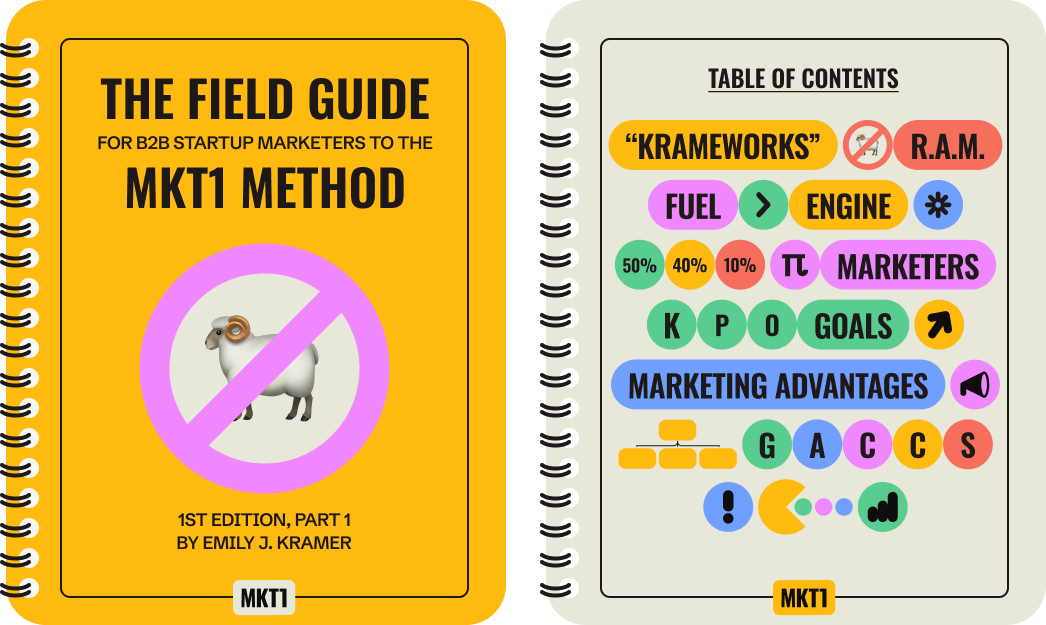
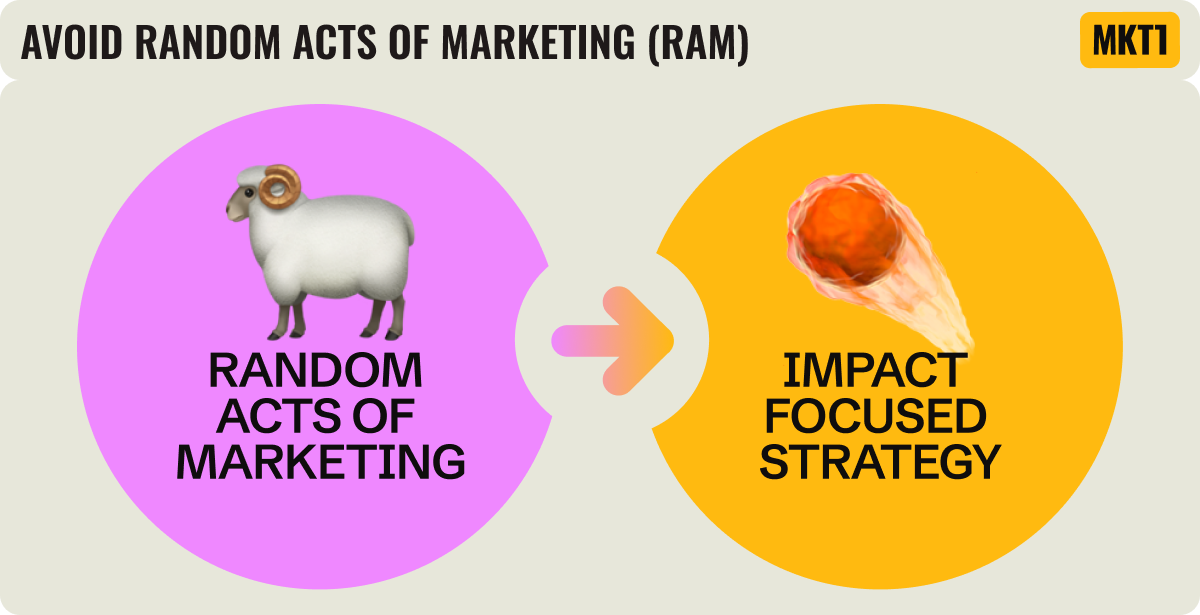
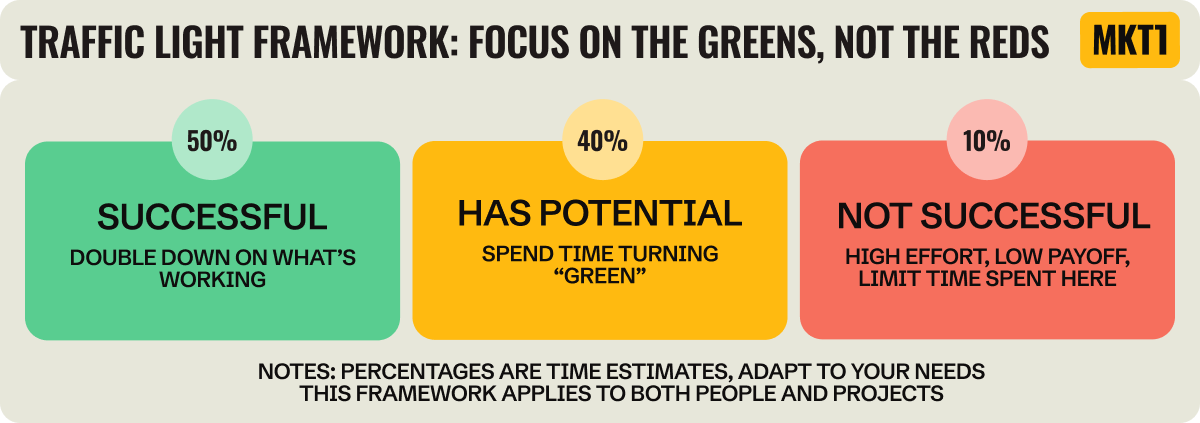
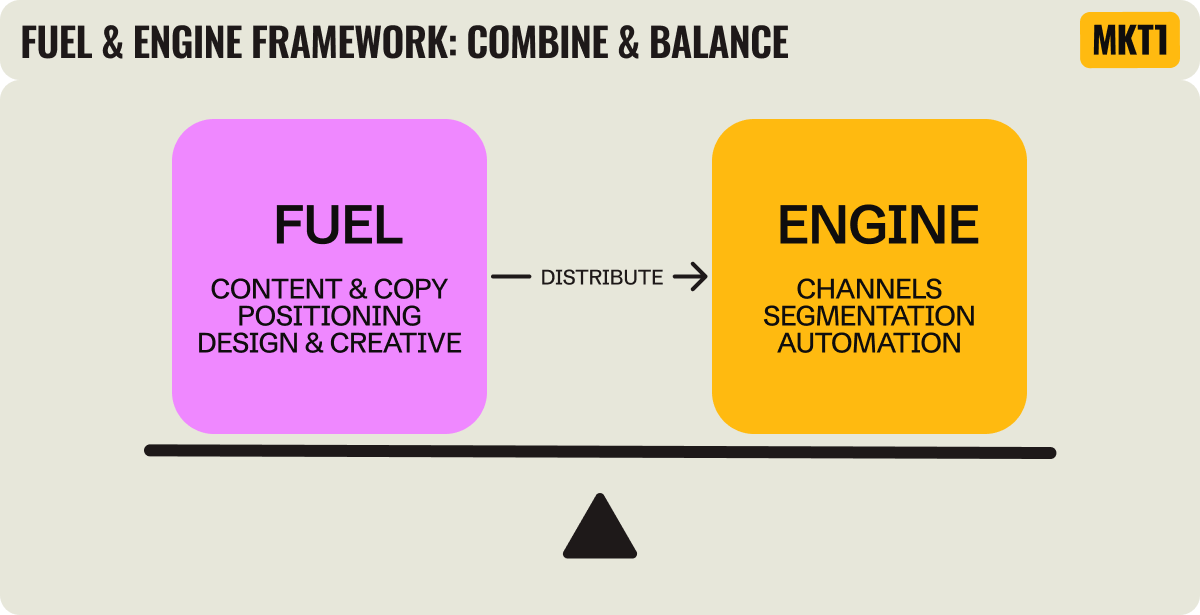
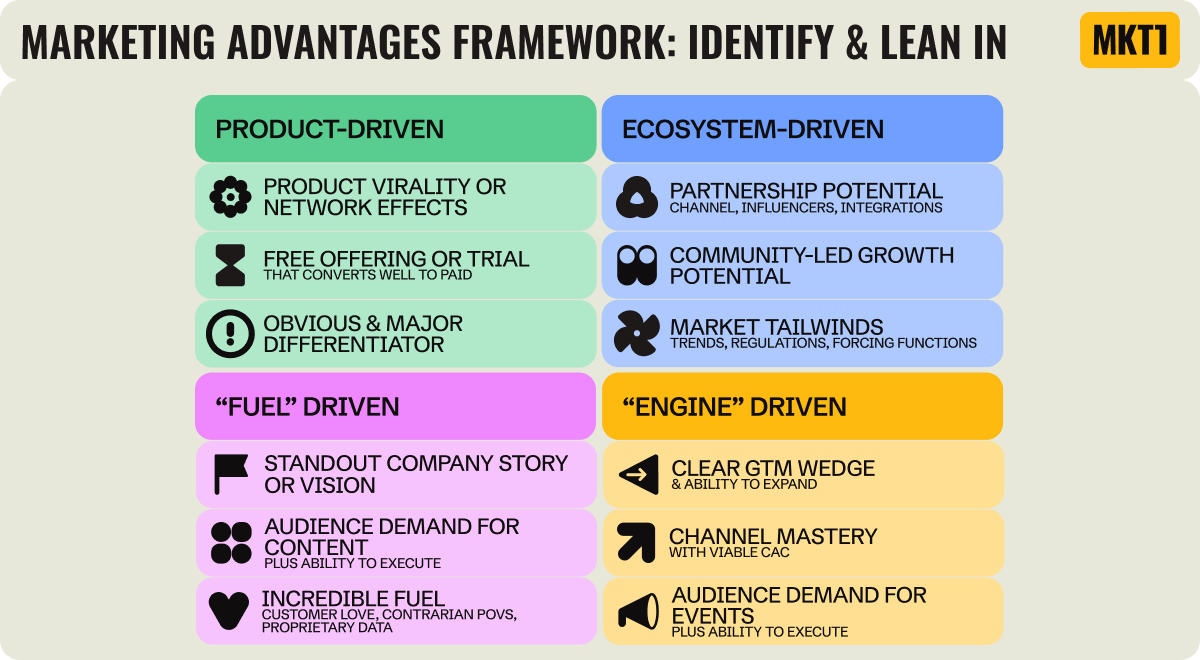
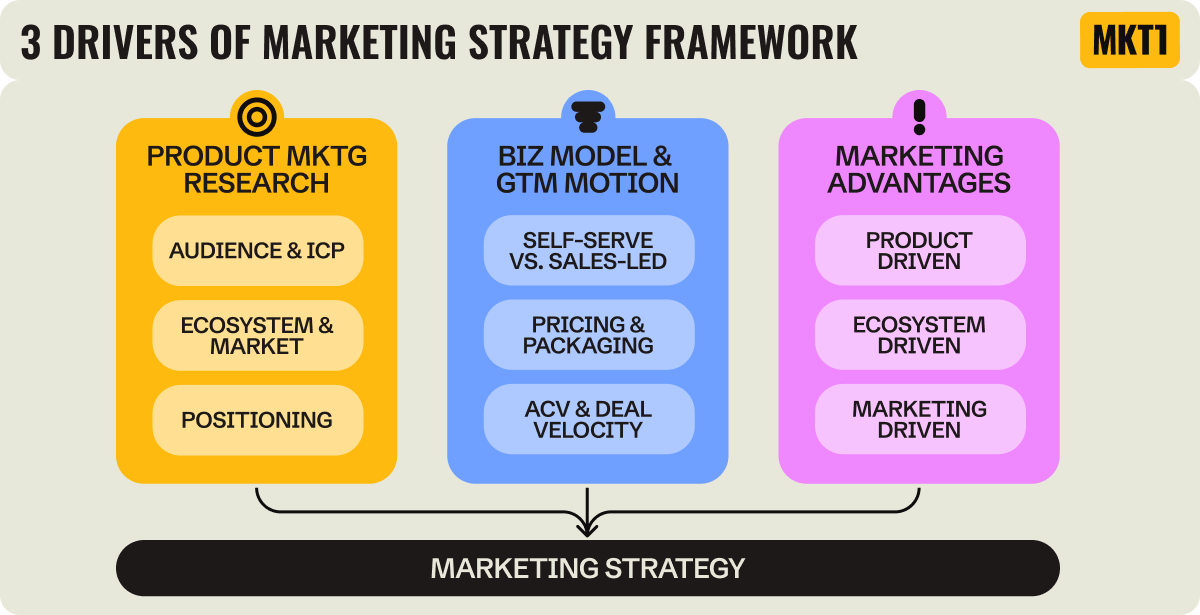
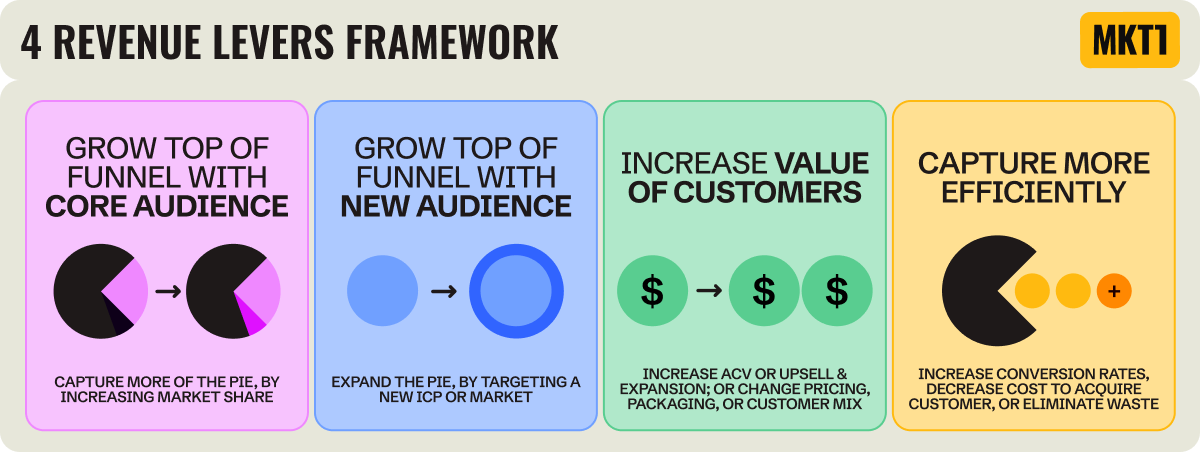
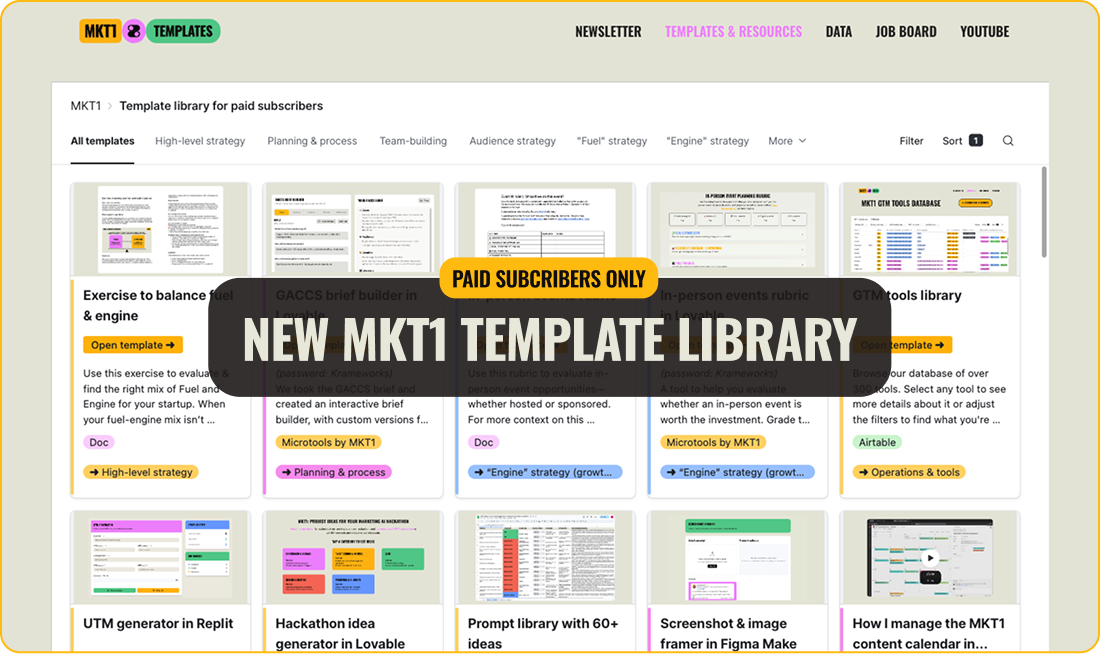
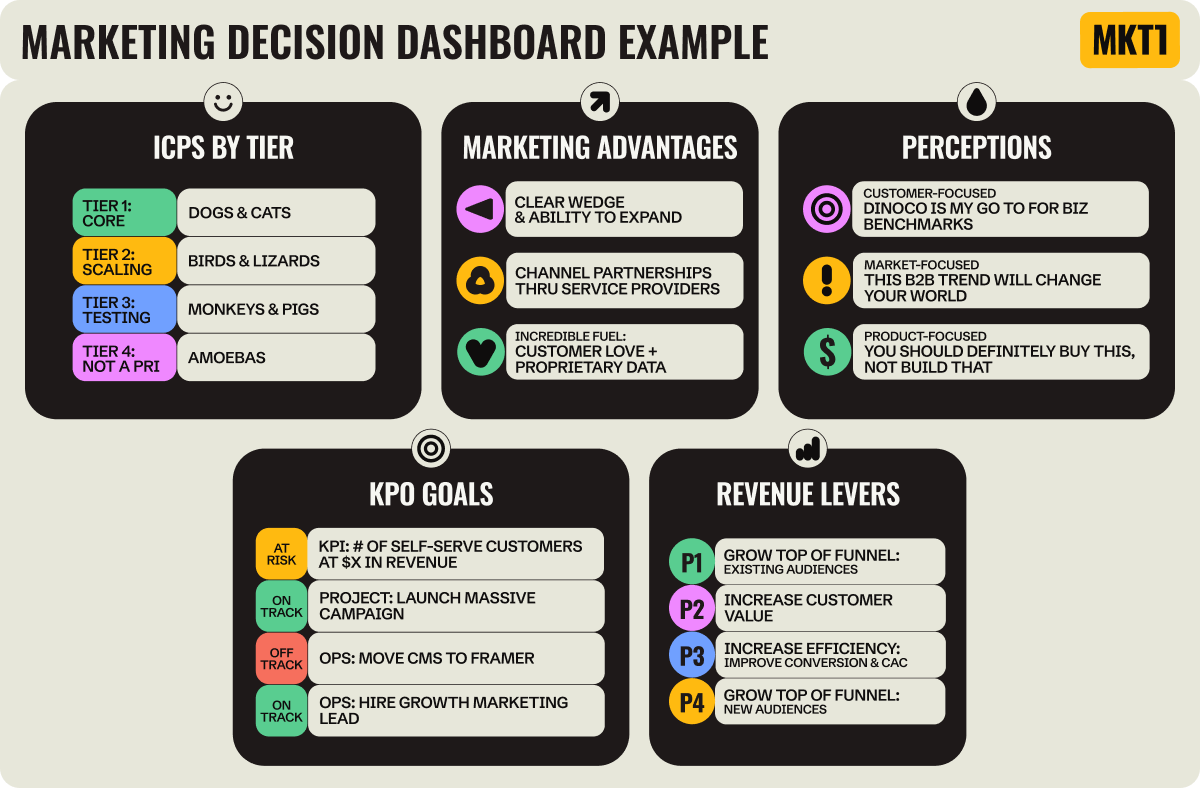
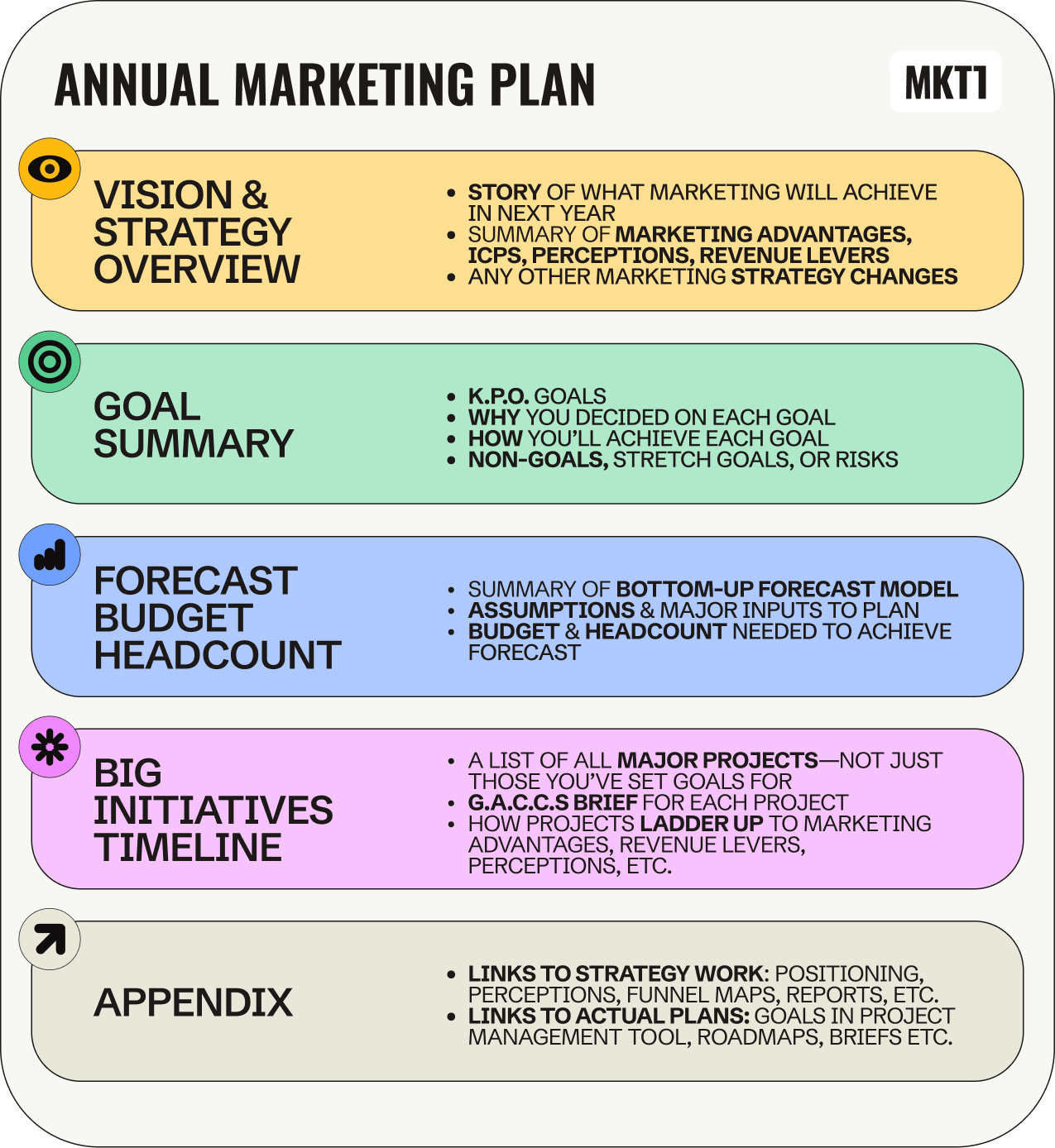

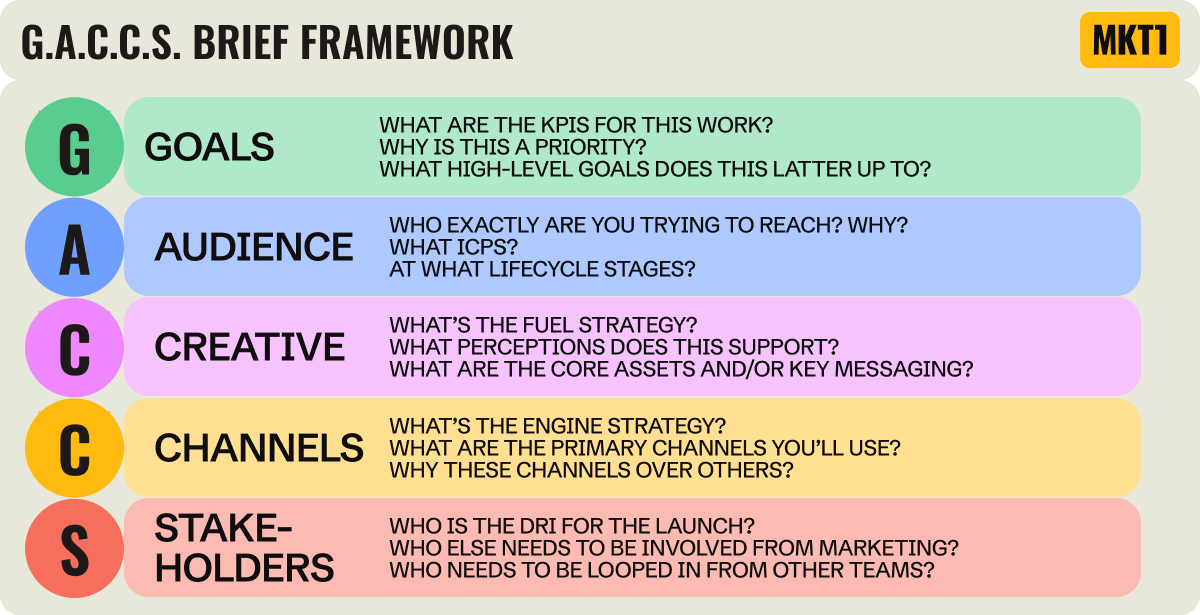
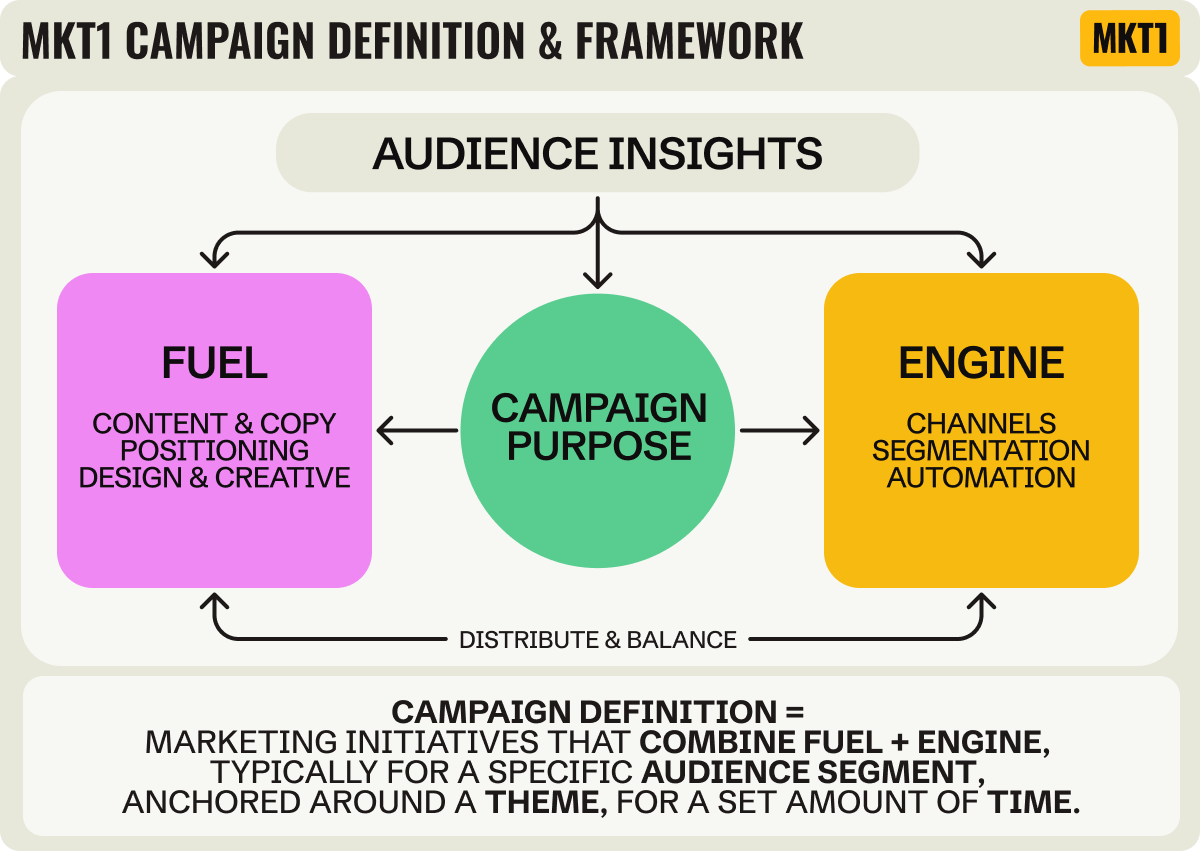
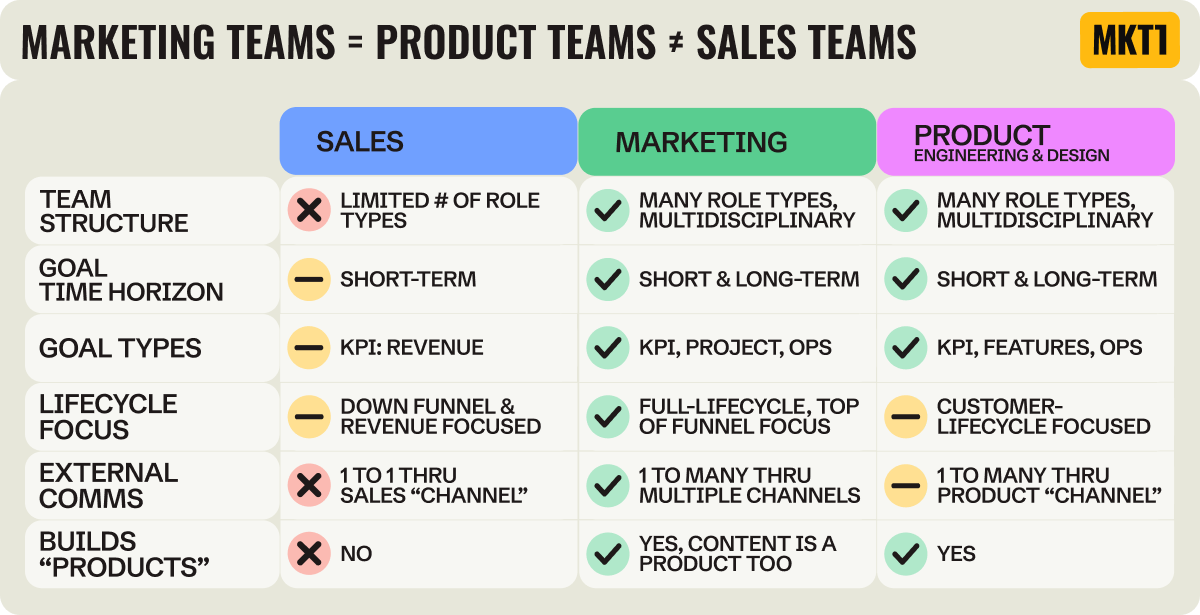
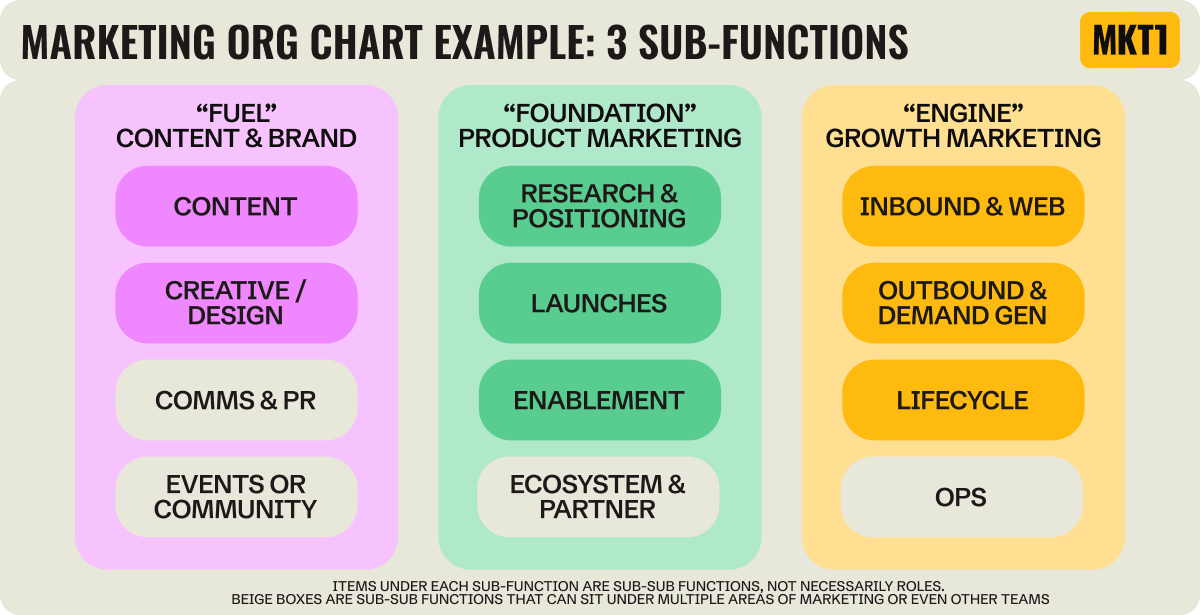
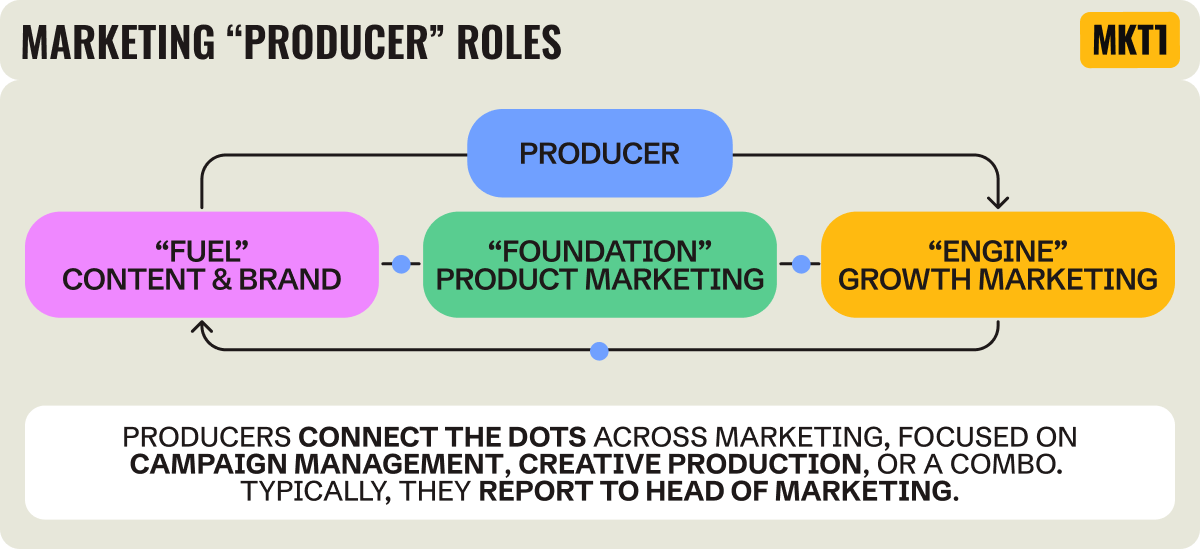
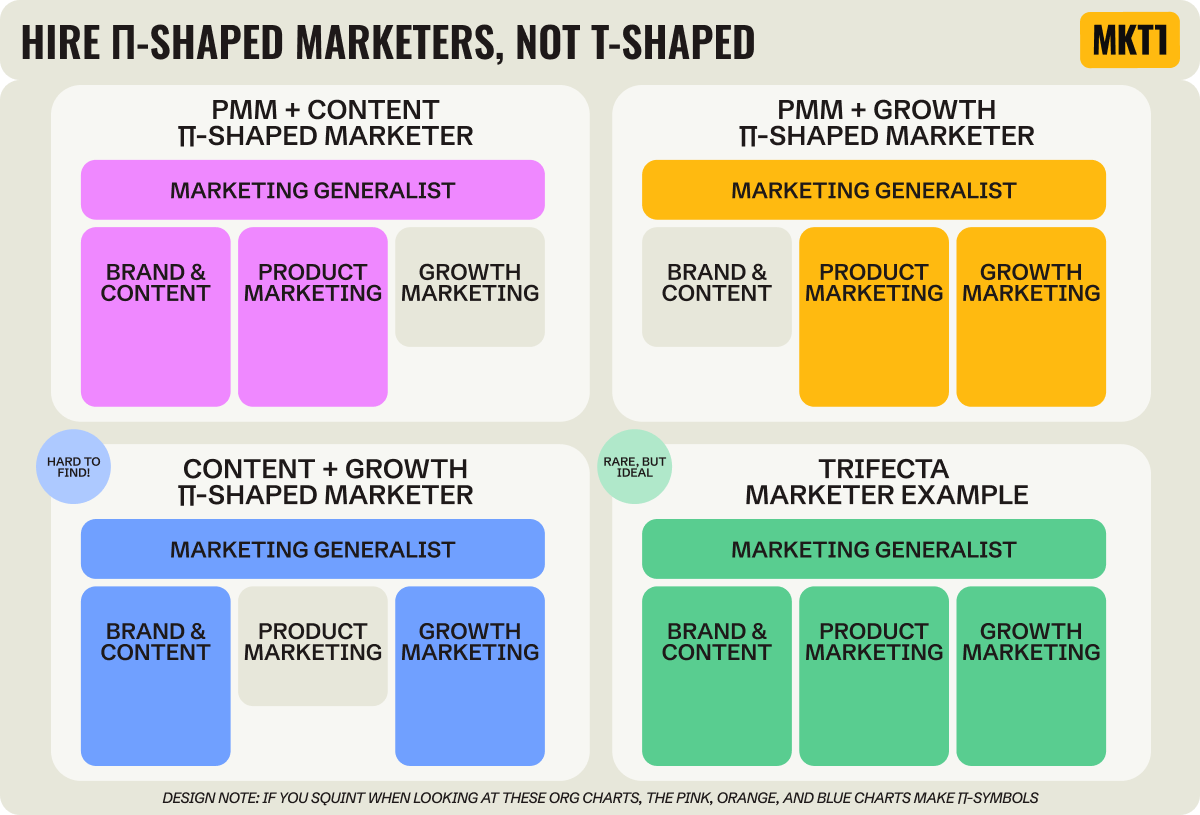
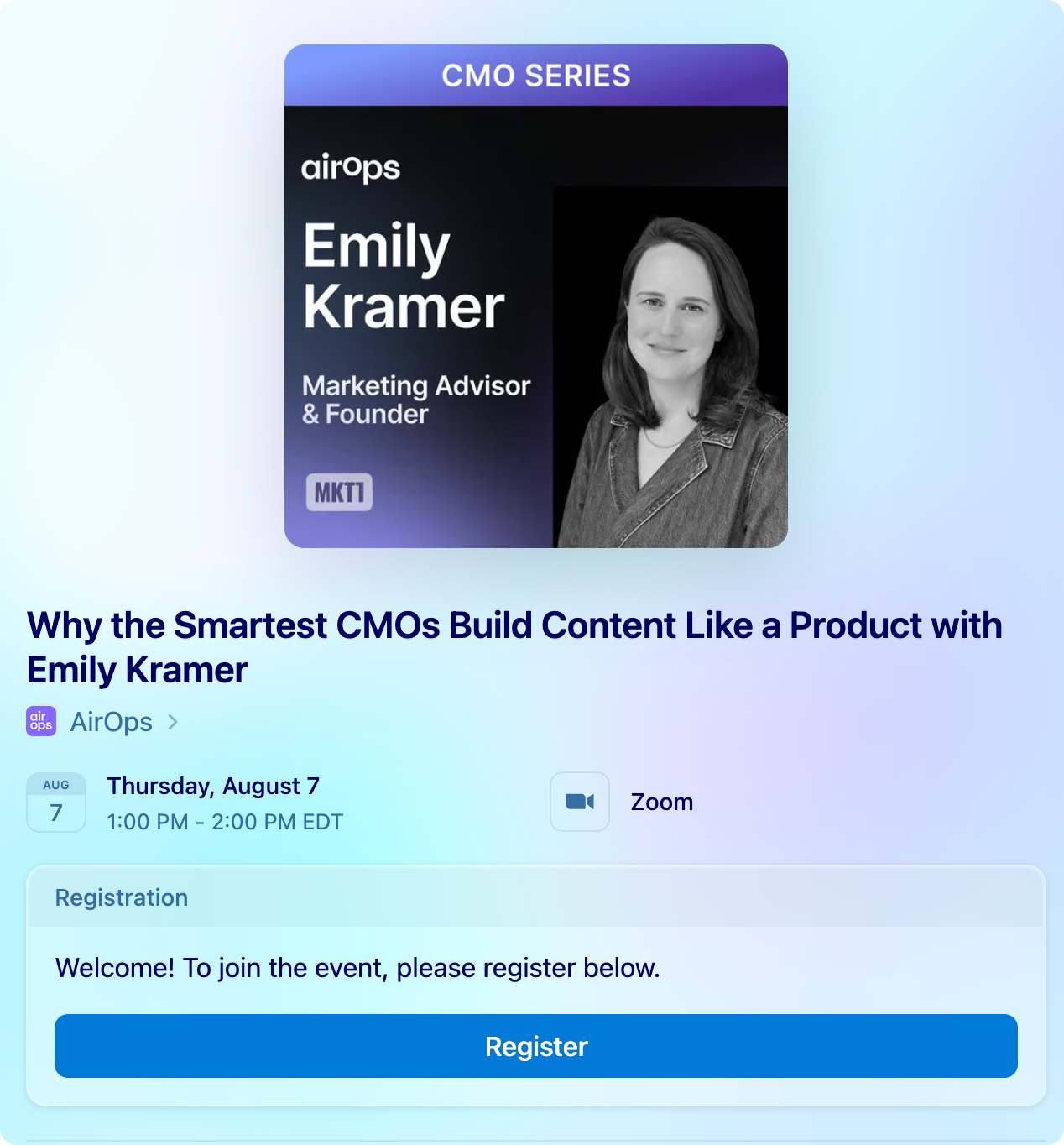
A real masterpiece, thanks Emily.
Most realistic and understandable, brilliant work, and also visuals